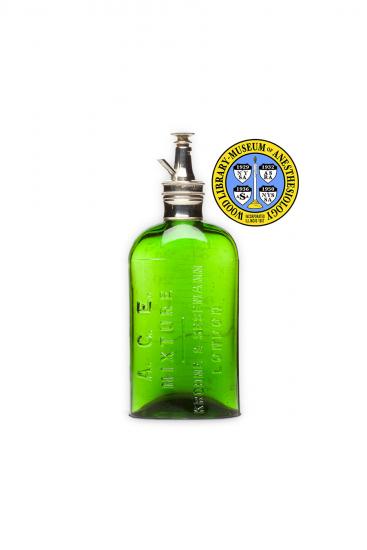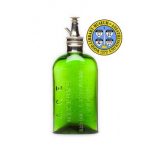Thomas A.C.E. Bottle
In 1866, the English surgeon and obstetrician Robert Ellis (1823-1885) introduced the first inhaler that mixed alcohol, chloroform and ether ( "A.C.E.") The mixture was advocated by Sir Frederic W. Hewitt in the 1890s and 1900s. It was later recognized that the combination was more dangerous than the use of either agent alone.
Specially designed drop bottles for ether and chloroform were first introduced in the 1870s. By the 1890s, the design shown here was known as the "Thomas bottle". A spring inside the cap, and a bayonet catch pin, allowed two settings for administering the drops. The same features helped to keep the cap tightly closed when not in use, to contain the vapor. This example of the Thomas bottle was designed for administering A. C. E. mixtures. It was made by the London instrument maker, Krohne & Sessemann. Because exposure to light degrades chloroform, most chloroform bottles were made of colored glass.
Catalog Record: Thomas A.C.E. Bottle
Access Key: akon
Accession No.: 2000-02-03-1
Title: A.C.E. mixture / Krohne & Sesemann.
Author: Thomas, J. Davies, 1844-1893.
Corporate Author: Krohne & Sesemann.
Title variation: Alt Title
Title: Thomas drop bottle.
Title variation: Alt Title
Title: ACE anesthetic mixture.
Title variation: Alt Title
Title: A. C. E. mixture.
Publisher: London : Krohne & Sesemann, [1878-1920].
Physical Descript: 1 bottle : glass ; 14.5 x 6 x 3.5 cm.
Subject: Chloroform.
Subject: Ethanol.
Subject: Ether, Ethyl.
Subject: Drug Packaging.
Note Type: General
Notes: The early year in the date range for the possible year of manufacture is
based on the 1878 catalog of the manufacturer’s, Krohne and Sesemann, that
did not include a Thomas drop bottle or mention of the A.C.E. Mixture.
Considering its absence from the 1878 catalog, it seems unlikely that Krohne
& Sesemann manufactured this bottle before 1878. The end date is an estimate
based on significant decreasing mention of the “A.C.E. Mixture” in anesthesia
literature after 1920. The date range could change if documentation indicates
it should be corrected.
Note Type: Citation
Notes: Catalogue of Surgical & Orthopaedic Instruments, Manufactured and Sold by
Krohne & Sesemann. London: Krohne & Sesemann; 1878. https://ia700608.us.
archive.org/3/items/catalogueofsurgi1878kroh/catalogueofsurgi1878kroh.pdf.
Accessed February 10, 2014.
Note Type: Citation
Notes: Defalque RJ, Wright AJ. The first anesthetic mixture [correspondence].
Anesthesiology. 1991;75(6):1118-1119.
Note Type: Citation
Notes: Illustrated Catalogue of Surgical Instruments and Appliances Manufactured and
Sold by Krohen & Sesemann. London: Krohne & Sesemann; 1901:328-335.
https://ia600609.us.archive.
org/19/items/catalogueofsurgi00kroh/catalogueofsurgi00kroh.pdf. Accessed
February 10, 2014.
Note Type: Citation
Notes: John Davies Thomas, M.D. Lond., F.R.C.S. Eng. [obituary]. Australian Med J.
February 15, 1895;15:90-91.
Note Type: Citation
Notes: Krohne, Charles William. AIM25 website. https://www.aim25.ac.
uk/cgi-bin/vcdf/detail?coll_id=6107&inst_id=26. Accessed February 10, 2014.
Note Type: Citation
Notes: Reeve JC. The A.C.E. mixture. In: Transactions of the Forty-Sixth Annual
Meeting of the Ohio State Medical Society. Toledo, Ohio: The Blade Printing &
Paper Co.; 1891:120-152.
Note Type: Citation
Notes: Report of the committee appointed by the Royal Medical and Chirurgical
Society to inquire into the uses and the physiological, therapeutical and
toxical effects of chloroform, as well as into the best mode of administering
it, and of obviating any ill consequences resulting from its administration.
Med Chir Trans. 1864;47:323-442.
Note Type: Citation
Notes: Sansom AE. On anaesthetic mixtures. In: Chloroform: Its Action and
Administration. London: John Churchill and Sons; 1865:137-141.
Note Type: Citation
Notes: Thomas JD. A new form of drop-bottle for chloroform, etc. Lancet. March 2,
1872;1:288.
Note Type: Citation
Notes: Thomas KB. Chloroform: commissions and omissions. Proc R Soc Med.
1974;67(8):723-730.
Note Type: Physical Description
Notes: One green glass bottle with a Thomas-like metal cap designed for dripping or
pouring liquid anesthetic; The approximate measurement 14.5 x 6 x 3.5 cm
includes the bottle and cap; Embossed on the bottle are manufacturer markings
and a graduated scale; The text includes “A.C.E. [new line] MIXTURE [new
line] KROHNE & SESEMANN [new line] LONDON”; On the right side the graduation
marks are numbered from 1 to 24; The numbered lines include 1, 2, 4, 8, 12,
16, 20, and 24; The numbers to the left of the graduation marks are difficult
to read, but appear to be a series of “1”s and “2”s; “Krohne & Sesemann [new
line] LONDON” is also marked on the metal cap.
Note Type: Reproduction
Notes: Photographed by Mr. Steve Donisch on June 12, 2013.
Note Type: Historical
Notes: In 1864 the ‘Chloroform Committee,’ organized by the Royal Medico-Chirurgical
Society to investigate deaths attributed to chloroform, recommended certain
mixtures of anesthetics believing they were safer than chloroform alone. A.C.
E. was one such mixture and its use increased after the release of the
Chloroform Committee’s report.
A.C.E. mixtures contained alcohol, chloroform and ether. Scottish physician,
Dr. George Harley (1829-1896) is recognized as first recommending this
mixture as 1 part alcohol, 2 parts chloroform, and 3 parts ether, although
other ratios were also commonly used.
The cap of this bottle was introduced by London physician J. Davies Thomas
(1844-1893) in 1872, three years before he left England for Australia.
Thomas drop bottles kept anesthetic from spilling out unexpectedly through
the use of a spring loaded stopper in the cap. The size of the stream was
controlled by a small spout that extended from the side of the cap. To pour
or drip anesthetic from the bottle, the anesthetist pushed the stopper down,
and slowly tilted the bottle with the spout facing downward.
Although Mayer and Meltzer first manufactured Dr. Tomas’ design, this
particular bottle was made by Krohne & Sesemann. Charles William Krohne was
born in Prussia in 1823. After founding a surgical equipment manufacturing
business in London he was joined by his half-brother, Henry Frederick
Sesemann, in 1860. In addition to the design and manufacture of surgical and
anesthetic apparatus, Krohne and Sesemann administered chloroform to patients
of physicians near their head offices. In the late 1880s, the business
expanded to supplying oxygen cylinders all over the country for Brin’s Oxygen
Co. In 1950, Krohne & Sesemann was acquired by Alfred Cox.
Note Type: Exhibition
Notes: Chosen for the WLM website (noted December 22, 2013).


